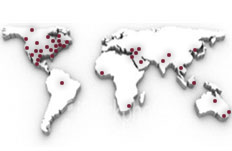WISENet™: A Wireless Sensor Network Architecture for Rail
Nature of the Problem
Railroads present a unique challenge to for providing wireless sensor capability. Railroad operators, like most other owners and operators of large fleets of vehicles, recognize the benefits of measuring and monitoring a number of vehicle parameters for purposes of both short term awareness of problems and for long term management of these resources.
But with many hundreds of thousands of rail cars, thouseands of locomotives, tens of thousands of miles of tracks, and a network of yards and maintenances facilities stretching from sea to sea, railroads require a specialized architectural solution to enable the fast and effective measurement, reporting, and use of sensor data.
IEM's WISE Solution
IEM’s WISENet™ provides a unique, adaptable, architectural design that meets the defined needs and restrictions of railroads. WISENet™ builds on several open standards to provide an adaptable, robust communication system for assuring that instrumented cars can provide real time data and alerts back to a central enterprise.
The core architecture supports a full mesh topology in which each sensor node may communicate with virtually any other sensor node in the network either through direct connection or via multi-hops. It is ultimately the “Car” that is managed by the sensor network, with sensor data from each car being transmitted by a Car Node through “Gateways” to the “Enterprise.” Car Nodes act as data-collection agents for any number of Sensor Nodes on board their designated railcar and establish a mesh topology for WISENet™ to pass sensor data between other Car Nodes and ultimately to an established Gateway.
Several important benefits emerge from building the WISENet™ architecture around the Car.
- Sensor Nodes spend more time collecting data and less time managing complex network communications
- Sensor Nodes operate at lower power because their need to communicate longer distances is reduced
- Sensor Nodes belong to a specific car and communicate to their Car Node via a car-level mesh topology (i.e., Sensor Nodes only need to route data to their Car Node) to assure connectivity
- Car Nodes collect and manage sensor data only from their own car
- A Car Node may serve advanced AEI tag functions
- Car Nodes implement the mesh topology for WISENet™ maintaining a dynamic routing map to a Gateway that always identifies the most direct and fastest pathway
- Understanding the “car” as an entity simplifies the process of building and initiating a train network, for determining car order, for calculating train length, for communicating with ‘lone cars’, and other desired network functions
- Eliminating Sensor Node level mesh network overhead significantly increases data throughput and network speed


